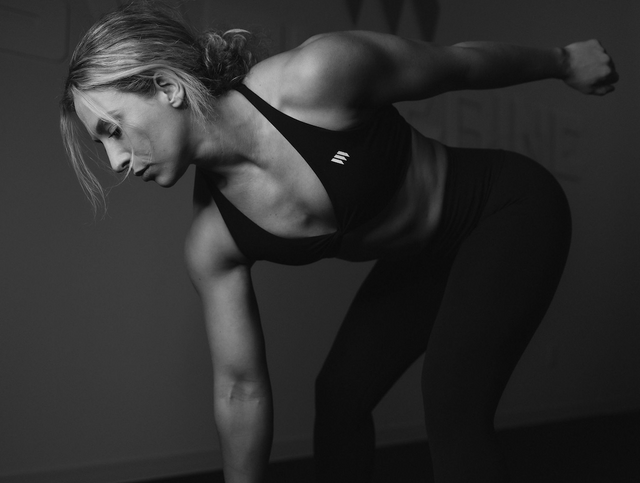Unleash the power of your lower body with the ultimate guide to mastering jump split squats! This explosive exercise is the secret weapon for sculpting stronger, more defined legs while boosting your athletic performance. Whether you're a fitness enthusiast looking to take your workouts to the next level or an athlete seeking to enhance your agility and power, jump split squats are a game-changer.
In this comprehensive guide, we unveil everything you need to know to perfect your form, optimize your technique, and maximize your results with jump split squats. From step-by-step instructions to pro tips and variations, we've got you covered.
Get ready to elevate your leg day routine and unlock the full potential of your lower body strength. Say goodbye to mundane workouts and hello to explosive gains with jump split squats!
What Is a Jump Split Squat?
A jump split squat is a plyometric exercise that combines a lunge with an explosive jump and a mid-air leg switch. It's an advanced movement that enhances lower-body strength, coordination, power, and cardiovascular endurance. This exercise targets the quadriceps, hamstrings, glutes, and calves, while also demanding core stability to maintain balance and proper form.
Understanding Jump Split Squats
Jump split squats merge the strength-building elements of a split squat with the explosive intensity of plyometrics. You begin in a split stance, lower into a squat, then jump and switch legs mid-air, landing back in a lunge on the opposite side.
This movement recruits both fast-twitch muscle fibers—responsible for power and speed—and slow-twitch fibers, which contribute to muscular endurance Schoenfeld et al., 2010. As such, it’s a hybrid exercise that helps improve strength, agility, and overall athleticism.
As you progress, you may see benefits such as:
-
Improved vertical jump
-
Enhanced sprint speed
-
Greater dynamic balance
-
Better coordination under fatigue
For beginners, the explosive element can be removed—starting with standard split squats. Advanced athletes can add dumbbells, weighted vests, or BOSU balls for instability training and increased difficulty.
Benefits of Jump Split Squats
1. Building Leg Strength
The jump split squat targets major muscle groups including the quads, glutes, and hamstrings. The concentric phase (the jump) forces these muscles to fire explosively, which builds muscular strength and hypertrophy Wilson et al., 2012. Practicing this movement regularly can help with increased strength output in lifts like the squat, deadlift, or leg press.
2. Improves Cardiovascular Fitness
As a high-intensity functional movement, jump split squats elevate the heart rate rapidly, making them ideal for High-Intensity Interval Training (HIIT) circuits. This promotes fat oxidation, calorie burn, and cardiovascular efficiency Boutcher, 2011, making it a dual-purpose exercise for both strength and conditioning.
3. Better Balance and Coordination
Every rep demands balance during the transition and landing. Engaging the core, hip stabilizers, and proprioceptors enhances neuromuscular coordination, which carries over into athletic performance and reduces injury risk Gruber et al., 2005.
Muscles Targeted in Jump Split Squats
Jump split squats provide a comprehensive lower-body workout, engaging multiple muscle groups:
-
Quadriceps: These work eccentrically as you descend and concentrically as you jump.
-
Glutes: Provide hip extension power and pelvic stability, especially during push-off.
-
Hamstrings: Support knee stabilization and deceleration during the descent.
-
Calves: Assist with propulsion and landing control.
-
Core: Keeps the torso upright and balanced throughout the movement.
This makes jump split squats not only a muscle-building movement but also a functional training staple.
Proper Form and Technique
To execute jump split squats correctly and avoid injury:
-
Start Position: Stand with feet shoulder-width apart. Step one foot back into a lunge, keeping the front knee directly above the ankle.
-
Descent: Lower until your back knee is just above the ground, keeping your torso upright and core braced.
-
Jump and Switch: Swing your arms and explode upward. While in the air, switch leg positions.
-
Landing: Land softly with your knees slightly bent, immediately lowering into another lunge on the opposite side.
✅ Form tips:
-
Keep your chest up and spine neutral.
-
Avoid leaning forward or arching the back.
-
Land softly to minimize joint impact and reduce injury risk Derrick et al., 1998.
Recording yourself or using a mirror can help identify technical errors like uneven leg landing or excessive torso movement.
Whether you're an athlete, weekend warrior, or just looking to level up your leg day, jump split squats deliver a powerful combination of strength, speed, and endurance. Their scalable nature and high metabolic demand make them perfect for programs targeting body recomposition, functional performance, or explosive power.
Incorporate them 1–2 times per week either as a standalone strength move or in a HIIT-style circuit to reap the full benefits.
How to Perform a Jump Split Squat with Proper Form - In Summary
Follow these step-by-step instructions to master the jump split squat.
Step 1: Start in a Split Stance
- Stand tall with your feet hip-width apart.
- Step one foot forward and the other foot back into a lunge position.
- Keep your torso upright, shoulders back, and core engaged.
Step 2: Lower Into a Lunge
- Bend both knees to lower into a 90-degree angle.
- Your front knee should be aligned with your ankle (not over your toes).
- Your back knee should hover just above the ground.
Step 3: Explode Upwards
- Push through your front heel and jump explosively into the air.
- Switch legs mid-air so that the back foot moves forward and the front foot moves back.
Step 4: Land Softly in a Split Stance
- Land gently and in control, absorbing impact through your legs.
- Return to the lunge position with the opposite foot forward.
- Repeat for the desired number of reps.
Jump Split Squats: Build Explosive Power and Total-Body Control
A jump split squat is a high-intensity plyometric exercise designed to improve explosive strength, balance, and athletic coordination. It involves lunging into a split stance, jumping powerfully, switching legs mid-air, and landing in the opposite lunge. This movement targets the quads, hamstrings, glutes, calves, and core, offering a full lower-body and cardiovascular challenge.
Variations of Jump Split Squats
Once you’ve mastered the basic form, incorporating jump split squat variations is a powerful way to keep your routine fresh and adaptive.
Weighted Jump Split Squats
The weighted jump split squat involves holding a dumbbell or kettlebell in each hand, which increases resistance and overall intensity. The added weight activates more muscle fibers, increases mechanical tension, and enhances strength adaptations Schoenfeld, 2010. Begin with light weights to maintain proper form and joint alignment.
Plyometric Jump Split Squats with Pause
In this variation, you don’t switch legs mid-air. Instead, you focus on a vertical explosive jump, then land softly back into your starting split squat stance, pause briefly, and repeat. This increases time under tension, sharpens muscle control, and improves eccentric strength—key components of athletic performance Cormie et al., 2011.
Jump Split Squats on an Unstable Surface
For an added challenge, perform the movement on a stability disc, BOSU ball, or foam pad. These tools introduce an unstable environment, requiring greater core activation and proprioceptive control, which can improve overall neuromuscular coordination Gruber & Gollhofer, 2004.
Incorporating Jump Split Squats into Your Workout Routine
Jump split squats can be plugged into your training based on your goals—whether it's strength, endurance, or power.
As a Strength Finisher
Use them at the end of a lower-body lifting session to burn out the legs with explosive effort. After compound lifts like squats or deadlifts, perform 3–4 sets of 8–12 reps, resting 60–90 seconds between sets. The dynamic movement helps develop post-fatigue explosiveness.
For High-Intensity Interval Training (HIIT)
Include them in a circuit workout with movements like burpees, box jumps, or kettlebell swings. Perform jump split squats for 20–30 seconds, followed by 10–15 seconds of rest. This format elevates heart rate, improves VO2 max, and burns fat efficiently Boutcher, 2011.
As Part of Your Warm-Up
Use low-intensity bodyweight reps to activate the posterior chain and prepare for more intense lower-body work. Focus on controlled landings and short ranges of motion. This primes the central nervous system and reduces injury risk during performance-heavy sessions.
Tips for Mastering Jump Split Squats
To perform jump split squats safely and effectively, follow these expert-backed strategies.
1. Prioritize a Dynamic Warm-Up
Prepare your muscles and joints with mobility drills and dynamic stretches—especially for your hip flexors, quads, and ankles. A proper warm-up improves range of motion, neuromuscular activation, and overall movement quality Behm & Chaouachi, 2011.
2. Perfect Your Landing Mechanics
A controlled landing is essential. Land with:
-
Knees slightly bent
-
Feet hip- to shoulder-width apart
-
Core braced
Avoid stiff landings, which can increase joint stress. Train your landings by practicing small jumps to build muscle memory and impact absorption.
3. Be Progressive and Patient
Start with bodyweight reps and limit your volume if you're new to plyometrics. Gradually add reps, height, or load as your confidence and strength improve. Don’t rush progression—your joints, tendons, and muscles need time to adapt to the intensity.
Common Mistakes to Avoid
Even experienced lifters can fall into common traps when performing jump split squats.
❌ Poor Knee Tracking
Ensure your knees stay in line with your toes during both the descent and landing. Knee valgus (knees collapsing inward) increases the risk of ACL injuries, especially in female athletes Hewett et al., 2005.
❌ Hard Landings
Landing stiffly or on locked knees creates excessive ground reaction forces, which can lead to joint strain and overuse injuries. Always aim for a quiet landing, which indicates control.
❌ Rushing Through Reps
Jump split squats require precision, not speed. Sloppy reps lead to compromised form and potential injury. Focus on technique, control, and breathing rhythm.
Equipment and Gear for Jump Split Squats
While bodyweight is enough, the right gear can elevate both safety and performance.
Athletic Shoes
Choose shoes with:
-
Shock absorption
-
Lateral support
-
Flat, stable soles
Proper footwear reduces impact stress and improves landing control. Avoid running shoes with thick soles that may compromise stability.
Dumbbells or Kettlebells
Once your form is consistent, adding load increases resistance, promoting strength and muscle gains. Start light (10–15 lbs per hand) and progress over time.
Flooring and Stability Tools
Use a rubber mat, soft flooring, or a fitness platform to reduce joint strain and prevent slippage. For balance-based variations, BOSU balls or stability discs provide an extra stimulus for core engagement.
Conclusion: Jump Split Squats Belong In Your Workout
In conclusion, jump split squats are a powerful exercise that can transform your lower body workouts, enhancing strength, power, and athletic performance. By understanding the fundamentals of this movement and incorporating it into your fitness routine, you can unlock numerous benefits that will elevate your overall training. Remember to focus on proper form, gradually progress as you gain strength, and stay mindful of common mistakes to ensure a safe and effective workout.
To continue your journey with jump split squats, consider setting specific goals for yourself. Whether it's mastering the basic movement, increasing your jump height, or integrating advanced variations, having clear objectives will keep you motivated and focused. Additionally, don’t hesitate to seek guidance from fitness professionals or trainers who can provide personalized feedback and support.
As you become more confident in your jump split squat practice, explore ways to incorporate this exercise into a variety of training modalities. From HIIT workouts to strength training circuits, the versatility of jump split squats allows you to continually challenge yourself and keep your workouts engaging. Embrace the journey, and enjoy the explosive gains that come with mastering this dynamic exercise!
Find similar articles:
Fitness






